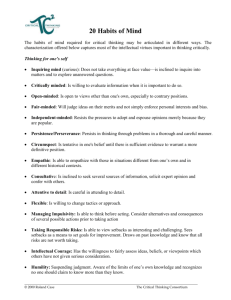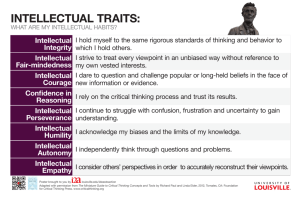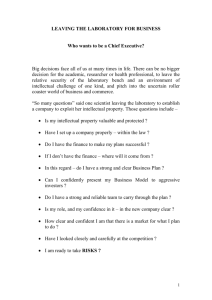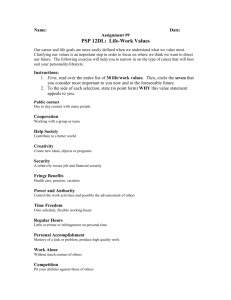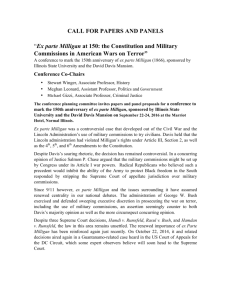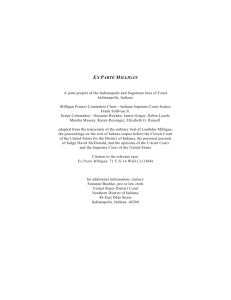LECTURE 09 (Notes) COPYRIGHT AND INTELLECTUAL PROPERTY
advertisement
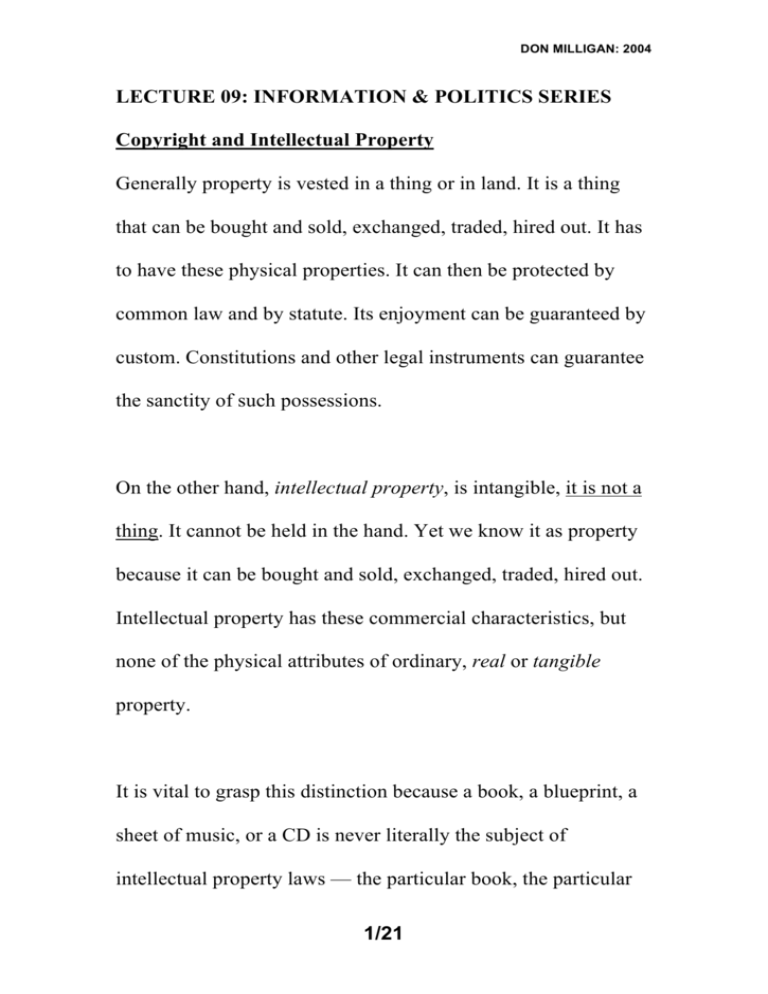
DON MILLIGAN: 2004 LECTURE 09: INFORMATION & POLITICS SERIES Copyright and Intellectual Property Generally property is vested in a thing or in land. It is a thing that can be bought and sold, exchanged, traded, hired out. It has to have these physical properties. It can then be protected by common law and by statute. Its enjoyment can be guaranteed by custom. Constitutions and other legal instruments can guarantee the sanctity of such possessions. On the other hand, intellectual property, is intangible, it is not a thing. It cannot be held in the hand. Yet we know it as property because it can be bought and sold, exchanged, traded, hired out. Intellectual property has these commercial characteristics, but none of the physical attributes of ordinary, real or tangible property. It is vital to grasp this distinction because a book, a blueprint, a sheet of music, or a CD is never literally the subject of intellectual property laws — the particular book, the particular 1/21 DON MILLIGAN: 2004 sheet of music, the particular CD, is not copyrighted. It is the specific arrangement of words or notes upon a page, which is copyrighted; it is the specific form of the music on the CD or the radio show, which is copyrighted. Of course, intellectual property is always attached to a physical thing; intellectual property is always carried by something with material qualities, but the intellectual property itself is not the physical thing, upon which, or in which, it is carried. If you buy a book in a shop, if you buy a CD in a shop, once you have paid your money legal title to that particular object changes hands — it becomes your book or your CD; your possession and the private enjoyment of it is protected by law and guaranteed by the state. However, you do not own the intellectual property contained within the book or the CD. The right to claim authorship, or the entirely separate right, to reproduce or copy the book or CD, is 2/21 DON MILLIGAN: 2004 not yours — in the shop you bought the tangible thing, not the intangible intellectual property. So the purchase of some writing or music or movies for your private enjoyment is sharply different from the purchase of the copyright to that writing, music or film. When somebody buys the copyright they purchase the right to reproduce the specific arrangement of words or notes upon a page; they purchase the right to copy the particular arrangement of sounds or images upon a disc. However, they are not the outright owners of the intellectual property because of what the lawyers call ‘moral right’. The sale of the copyright by an author to a publisher or a distributor does not undermine or abolish the author’s ‘moral right’. Thus the author remains the author whether she has sold the copyright to her novel or her research paper or not. She continues to have the right to be acknowledged as the author and is protected from the 3/21 DON MILLIGAN: 2004 mutilation or alteration of her work by the publisher or distributor to whom she sold the copyright. So, the author always has moral rights in relation to his creations. His play, his textbook, his blueprints always remain his, even though he may have sold the right to copy and distribute his work to another person or company. This lecture is, by ‘moral right’, my intellectual property. I wrote it, I have the right to be identified as its author, and I am protected from it being altered in any way by another person. However, I do not own the copyright. The copyright belongs to Manchester Metropolitan University because it is part of my contractual responsibilities, for which I am paid, to write lectures.1 Similarly, if a stock exchange or any other institution awards or sells the rights to distribute or disseminate information which it 1 See Jeremy Phillips, et. al., Whale on Copyright, London: Sweet & Maxwell, 1997, p.15. 4/21 DON MILLIGAN: 2004 has gathered together, to a news agency or information bureau, then the right to distribute the news about that information — stock or commodity prices for example — belongs to them.2 They have paid the authors or source of the information for the privilege of spreading the news. By payment they have changed legal title to this knowledge as if the knowledge was a thing. So, intellectual property has this threefold aspect: 1. The moral right of the author to protect the arrangement or form of his work and to be identified as its creator. 2. The commercial right of the copyright-holder to reproduce and distribute the work. 3. The right of those who have paid the copyright-holder for permission to enjoy the work in private, or the special right of those who have paid for permission use the work in public performances. It is from these three aspects that we can see the peculiar character of intellectual property and the ways in which it is a specific kind of property quite different from the property in 2 See J. W. Harris, Property & Justice, Oxford: Oxford University Press, 1996, pp.342-348. 5/21 DON MILLIGAN: 2004 things that we more easily identify as property belonging to a particular person or institution. Intellectual property exists in the form of (1) patents, (2) copyright, and (3) trademarks and industrial designs. These three different sorts of intellectual property are the subject of different legal provisions, but my focus is going to remain on copyright as the most common or widespread form of intellectual property — and the one in which we are most likely to encounter the law and the conflicts to which it gives rise. It is often difficult to believe that the copyright should be respected. It can, at times, appear to be at best, unjust, and at worst, simply insupportable. In this respect, our difficulties are revealed very clearly by the Universal Declaration of Human Rights adopted by the United Nations in 1948. Article 27: reads: 6/21 DON MILLIGAN: 2004 (1) Everyone has the right freely to participate in the cultural life of the community, to enjoy the arts and to share in scientific advancement and its benefits. (2) Everyone has the right to the protection of the moral and material interests resulting form any scientific, literary or artistic production of which he is the author.3 Now, clearly there is a conflict between these two rights: (1) the rights of the person or citizen to access cultural production of all sorts, and (2) the rights of the authors of that cultural production to benefit materially from their creative work. When teachers at MMU distribute photocopies of chapters taken from books they are providing access to work that you would not otherwise be able to read, or at least, not get hold of very easily. In doing so, they are I hope careful, always to include the title page of the book and the page bearing the book’s publication details. They do this for two reasons: (1) to make it 3 Universal Declaration of Human Right, Adopted and proclaimed by General Assembly resolution 217 A (III) of 10 December 1948, quoted from the website http://www.un.org/Overview/rights.html last visited on 18/02/04. 7/21 DON MILLIGAN: 2004 easier for you to find the book should you want to read more of it, and (2) to support the ‘moral right’ of the author to recognition for having written the book. In doing so, strictly speaking, they are breaching the publishers and the author’s copyright. However, except in the case of popular textbooks or manuals they could not be said to be damaging the sales of the author or publisher by handing out photocopies taken from very expensive, hardback, academic works. If lecturers stopped their photocopying — it is unlikely that you would rush out and buy copies of these books, and you would in all probability never hear of most of these authors without the photocopies. So, a balance has to be struck. For example, I do not photocopy computer application manuals. I have to write my own training exercises and materials. This is because, if I photocopied those published by Microsoft or other publishers in the field I would clearly be challenging or undermining their commercial 8/21 DON MILLIGAN: 2004 interests; I would be breaching their copyright in every material and legal sense. There is certainly a paradox hiding in this practice, which is common in colleges and universities all over the world. The copyright to the popular, best selling, most profitable works is respected, while that of the most obscure and least profitable is routinely violated. It is a paradox that prevents universities and colleges from being routinely prosecuted and ensures that generations of students have free and easy access to material they would otherwise not see.4 Where this paradox does not exist is in music or movie publishing. Here, it is the most popular, and hence the most profitable music or movies, which are pirated. This is why illegal copying of CDs and DVDs attracts such attention: the material interests of the copyright-holders are being directly 4 See ‘Limitations on exclusive rights: fair use’ at http://www.law.cornell.edu/uscode/17/107.shtml [This note was added in July 2009]. 9/21 DON MILLIGAN: 2004 affected. Copyright piracy is resulting in a loss of revenue, which in law, belongs to the copyright-holders. It is worth pausing to reflect how we got into this peculiar situation. It worth looking briefly at the history of copyright to get some understanding of how this form of property first came into being. It is worth doing this because this history reveals why modern technologies have put the law under such strain and created what can only be described as a crisis in compliance and, consequently, in enforcement of the law. Before William Caxton introduced printing with moveable type into England in 1476 the reproduction of literary works in any volume above two or three copies was impossible. As printing presses became more established and the trade expanded it became necessary for the Tudor state to exercise control over the copying and reproduction of books. The Crown granted Letters Patent to a particular printer giving him exclusive rights to print and sell particular manuscripts or works. 10/21 DON MILLIGAN: 2004 This practice was regularised by a decree of the Star Chamber in 1556, which granted the monopoly of the copying of all books and manuscripts to members of the Stationers’ Company of the City of London. However, this kind of regulation was not aimed at protecting the income or status of authors. The control of the import and copying of all manuscripts and books by the Crown and the regulation of all printing and bookselling, on behalf of the Crown, by the Stationers’ Company was a guarantee of political control over the dissemination of ideas and opinions. This state control was periodically strengthened by new decrees of the Star Chamber, particularly by that of 1637, which insisted that all books be licensed and entered in the ‘register book’ of the Stationers’ Company. The Star Chamber was abolished in 1640 and in 1643 the Long Parliament adopted an ‘Act for Redressing Disorders in Printing’. This act, retained the role of the Stationers in licensing 11/21 DON MILLIGAN: 2004 and registering all publication, but recognised that books and manuscripts could not be printed and sold without the express permission of their authors. However, it is not until we see the emergence of capitalism — the emergence of a market in literary works that something like the modern copyright laws began to come into existence. The last of the old political acts, The Licensing Act of 1662, was repealed in 1694 when the registration and censorship enforced on behalf of the Crown by the Stationers’ Company was abolished. For some years there was no copyright protection of any sort. In fact, it was not until the “Act for the Encouragement of Learning by vesting the Copies of printed Books in the Authors or Purchases of such Copies during the Times therein mentioned” passed during the reign of Queen Anne in 1709 that the rights of 12/21 DON MILLIGAN: 2004 authors and, of the printers and booksellers to whom the authors had sold or assigned their rights, received any protection. The word modern word ‘copyright’ does not come into use until the late 1730s.5 And it is from the middle of the eighteenth century, with the development of a fairly large and growing market in literary works that copyright becomes firmly established and is clearly separated from any issues concerning registration and censorship. From the Universities Copyright Act of 1775 printers and booksellers had to deposit nine free copies of the books they published. And from the case of Beckford v. Hood in 1798 it became established that copyright was created automatically by publication — you did not need to register or establish your copyright — it was automatically created by the publication of your work.6 This is the basis of our modern law. 5 See Roy Wiles, Serial Publication in England before 1750, Cambridge: Cambridge University Press, 1957, passim. 6 Phillips, et. al. Whale on Copyright, p.6. 13/21 DON MILLIGAN: 2004 In due course, engraving, sculpture, plays, paintings, drawings, photographs, maps, pamphlets and sheet music received the express protection of the law and the length of copyright protection was steadily extended.7 All of these eighteenth and nineteenth century statutes were brought together and codified in the Act of 1911. Since then copyright has been specifically extended to broadcasting (1956), cable transmission (1984) and to software in the 1985 Copyright Amendment (Computer Software) Act — in this act computer programs were said to be like ‘literary works’. All this modern legislation was codified, made firmer and more explicit, in the Copyright, Designs and Patents Act of 1988. This, and the directives of the old EEC and the subsequent directives of the European Union form the backbone of the modern law. 7 Engraving Copyright Act 1734; Sculpture Copyright Act 1814; Dramatic Copyright Act 1833; Fine Arts Copyright Act 1862; and, the Act of 1842 which covered maps, books, pamphlets, sheet music, plans, and extended protection to 42 or seven years from the author’s death, whichever was longer. 14/21 DON MILLIGAN: 2004 So, copyright comes into existence with the market in literary works and is strengthened as that market in intellectual property is extended to include works of art, photographs, phonograph records and moving pictures. However, until very recently, copyright did not affect ordinary members of the public; copyright did not impinge on the life or conduct of the ordinary consumer. Copyright was a matter of concern to publishers, distributors and authors. Copyright regulated commercial relations between publishers, distributors, and authors — it had nothing to do with the mass of people who bought books, watched television shows, or bought cinema tickets. This situation was altered fundamentally by changes in technology. In 1958 the Haloid Company changed its name to Haloid Xerox Inc. and the following year announced the invention of the first plain paper copier. In 1961 the company was floated on the New York Stock Exchange and changed its 15/21 DON MILLIGAN: 2004 name to Xerox. By 1988 the company had sold 2 million Xerox copiers.8 These developments, together with the development of offset lithography, and more recently of the digitalisation of intellectual property and its dissemination via distributed computer networks have created an entirely new set of circumstances. Matters concerning copyright are no longer restricted to publishers, distributors or authors — now that more or less everybody can copy and distribute material we are all, potentially at least, publishers. We can all use our access to ICT to copy and distribute intellectual property in violation of the rights of the copyright-holders. This, situation did not arise over night. In fact it began during the second industrial revolution with improvements in photography and printing that made piracy and particularly, 8 See the websites of Indiana University Purdue University Indianapolis, http://www.iupui.edu/ and http://webphysics.iupui.edu/251/251Sp97GFJan20.html last visited on 18/02/04. 16/21 DON MILLIGAN: 2004 international piracy a matter of concern. Consequently, the Berne Convention for the Protection of Literary and Artistic Works was established in 1886. And, the Berne Copyright Union was established in the same year. A growing number of countries signed up in an attempt to prevent cross-border piracy of books, photographs and subsequently, movies. Over the years these conventions have been strengthened by the development of new conventions, new international bodies and new international agencies like the World Intellectual Property Organisation (WIPO). However, it was not until the end of the Uruguay Round of multilateral trade negations that attempts to harmonise international intellectual property rights protection were fully integrated into work of GATT and the World Trade Organisation. In the Final Act signed on April 15th 1994 at Marrakech in Morocco, the negotiating states agreed to regulate and protect trade-related aspects of intellectual property rights. It 17/21 DON MILLIGAN: 2004 was agreed that TRIPs — Trade Related Aspects of Intellectual Property Rights — would be overseen by the World Trade Organisation.9 It is now recognised particularly in pharmaceuticals, biotechnology, scientific knowledge of all sorts, in technology transfer, that protection of intellectual property is central to the world trading system and to the integrity of the full development of capitalist relations on a global scale. This has had some extraordinary effects, from the patenting of the genetic structure of living creatures to the patenting by Western multinational companies of particular, plants, beans, and trees. Of more immediate concern to us when considering the role of ICT in all of this is the development of electronic copyright management systems (ECMS). These systems are being piloted 9 Christopher May, A Global Political Economy of Intellectual Property Rights: The New Enclosures?, London: Routledge, 2000, p.67. See also the World Trade Organisation site at WTO ‘Intellectual Property’, http://www.wto.org/english/tratop_e/trips_e/trips_e.htm, last visited 30/11/05. 18/21 DON MILLIGAN: 2004 in order to “create a technological and organisational infrastructure that allows creators of an original information product to enforce their copyright in the product when it is accessed online”.10 In other words, it is intended that ECMS be used to register author’s copyright online and to allow people, on payment of a fee, to access protected works from a database. It also involves developing the capacity to ensure that individuals are not illegally copying in the privacy of their own homes on their own equipment. While it is permitted for you to make a back-up copy of software, you are not allow to copy software or to access databases — because by holding this material even temporarily in the RAM of your computer — you are illegally copying protected material.11 10 Lee A. Bygrave and Kamiel J. Koelman, ‘Privacy, Data Protection and Copyright’ in P. Bernt Hugenholtz (ed.), Copyright and Electronic Commerce, London: Kluwer Law International, 2000, p.60. See also Y. Rogier, B. Stanford-Smith, P. T. Kidd, Advances in Information Technologies, Amsterdam: IOS Press, 2000, pp.428-430. 11 Council Directive 91/250/EEC of 14 May 1991 on the legal protection of computer programs OJ L 122/42; Council Directive 96/9/EC of 11 March 1996 on the legal protection of databases OJ L 77/20; see also, Bygrave et. al. ‘Privacy, Data Protection and Copyright’, pp104-106. 19/21 DON MILLIGAN: 2004 So, to sum up, copyright emerged with the market in literary and artistic works during the eighteenth century. Until the nineteen eighties it was a matter of concern only to those engaged in creating, publishing or distributing creative works. More recently, the protection of intellectual property has become a matter of key importance in international trade and because of the digitalisation of information and the spread of distributed computer networks copyright now, in one way or another, effects the entire population. BYGRAVE, Lee A., and KOELMAN, Kamiel J., ‘Privacy, Data Protection and Copyright: Their Interaction in the Context of Electronic Copyright Management Systems’, in P. Bernt Hugenholtz (ed.), Copyright and Electronic Commerce: Legal Aspects of Electronic Copyright Management, London: Kluwer Law International, 2000, pp.59-124. DENT John R. L. Dent, A Guide to Copyright in Corporate Film and Video Programmes, Peterborough: Guild Editions, 1990. HARRIS, J. W. Property & Justice, Oxford: Oxford University Press, 1996. INDIANA University Purdue University Indianapolis, http://www.iupui.edu/ 18/02/04. 20/21 DON MILLIGAN: 2004 MAY, Christopher, A Global Political Economy of Intellectual Property Rights: The New Enclosures?, London: Routledge, 2000. PHILLIPS, Jeremy, DURIE, Robyn, and KARET, Ian, Whale on Copyright, London: Sweet & Maxwell, 1997. UNITED NATIONS, Universal Declaration of Human Right, Adopted and proclaimed by General Assembly resolution 217 A (III) of 10 December 1948, quoted from the website http://www.un.org/Overview/rights.html last visited on 18/02/04. WILES, Roy, Serial Publication in England before 1750, Cambridge: Cambridge University Press, 1957. 21/21




